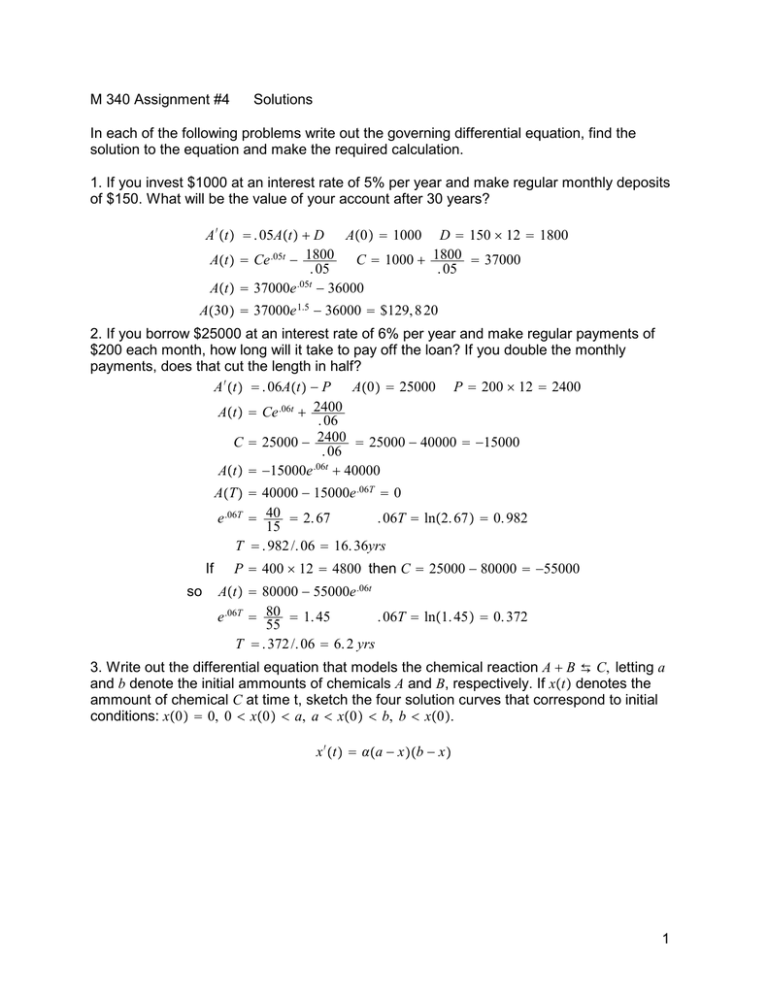M 340 Assignment #4 Solutions
advertisement

M 340 Assignment #4 Solutions In each of the following problems write out the governing differential equation, find the solution to the equation and make the required calculation. 1. If you invest $1000 at an interest rate of 5% per year and make regular monthly deposits of $150. What will be the value of your account after 30 years? A t . 05A t D A0 Ce .05t 1800 C . 05 37000e .05t 36000 At At 37000e 1.5 A 30 36000 1000 1000 D 150 12 1800 37000 . 05 1800 $129, 8 20 2. If you borrow $25000 at an interest rate of 6% per year and make regular payments of $200 each month, how long will it take to pay off the loan? If you double the monthly payments, does that cut the length in half? A t . 06A t P A0 25000 P 200 12 2400 At Ce .06t 2400 . 06 C 25000 2400 25000 40000 15000 . 06 At 15000e .06t 40000 T 40000 15000e .06T 0 40 2. 67 . 06T 15 . 982 /. 06 16. 36yrs P 400 AT e .06T If so At e .06T T 12 4800 then C ln 2. 67 25000 0. 982 80000 55000 .06t 80000 55000e 80 1. 45 . 06T 55 . 372 /. 06 6. 2 yrs ln 1. 45 0. 372 3. Write out the differential equation that models the chemical reaction A B C, letting a and b denote the initial ammounts of chemicals A and B, respectively. If x t denotes the ammount of chemical C at time t, sketch the four solution curves that correspond to initial conditions: x 0 0, 0 x 0 a, a x 0 b, b x 0 . x t a x b x 1 4. An electric circuit contains a resistance, R, and a capacitance, C, and is driven by an alternating current E 0 cos t. What is the amplitude of the response, i t , expressed in terms of R, C, and E 0 ? Ri t Ri t 1Qt C 1it C it i0 it it it cos Amplitude E 0 cos t, E 0 sin t, i0 0 C E 0 sin t C 2 R 2 E 0 cos t 2 2 2 C R 1 2 2 E0C R a 0 C2R2 2 1 E 0 C 2 R 2 e t/RC E C sin t RC cos t 0 C2R2 2 1 C2R2 2 1 R C cos t sin t E0C E 0 C 2 R 2 e t/RC C2R2 2 1 C2R2 2 1 C2R2 2 1 E0C E0C cos cos t sin sin t e 2 2 2 2 2 2 R 1 C C R 1 ae 1 CR t R C C2R2 2 E0C C2R2 2 sin 1 t/RC 1 C2R2 2 1 1 5.An electric circuit contains a resistance, R, and an inductance, L, and is driven by an alternating current E 0 cos t. What is the amplitude of the response, i t , expressed in terms of R, L, and E 0 ? L di dt Ri it i0 it it cos Amplitude E 0 cos t i0 0 1 RE 0 cos t L E 0 sin t Ce L Rt 2 2 2 L R RE 0 C 0 L2 2 R2 1 RE 0 L sin t E 0 R cos t e L Rt 2 2 2 L R L2 2 R2 E0 RE 0 cos cos t sin sin t e 2 L 2 R2 L2 2 R2 R L sin 2 2 2 2 2 L R L R2 E0 2 2 L R2 1 L Rt 2